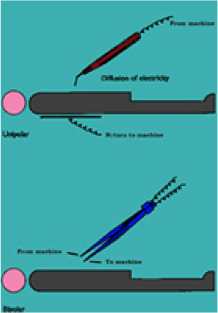Electrosurgery
Definitions
 Electrocautery: The use of a high amperage, low voltage, electric current to heat wire or filament which causes thermal damage. The current does not pass through the patient.
Electrocautery: The use of a high amperage, low voltage, electric current to heat wire or filament which causes thermal damage. The current does not pass through the patient.
Indication – cheap, controlled tissue destruction. Self-sterilising. Will work in bloody fields, and on non-conductive tissue such as nail. It is safe with electronic equipment, such as pacemakers.
Electrolysis or Galvanic Surgery: The negative pole of a galvanic (DC) current liberates hydroxides, which liquefy protein within the lesion causing its destruction.
Indication – mainly for hair follicle destruction.
High Frequency Electrosurgery: A high frequency (AC) current passes directly into the tissue causing heat. It can be varied to destroy, cut, or coagulate. Unlike an electrocautery, the electrode tip does not itself get hot. It may be Monoterminal (Monopolar) in which the patient acts as a conductor and there is a plate on the skin and a return lead to complete the circuit, or Biterminal (Bipolar).
Diathermy: The creation of heat by the passage of a current through tissues. The high frequency generates heat  where the current is concentrated at the hand-held electrode tip.
where the current is concentrated at the hand-held electrode tip.
Electrofulguration is produced by a very high voltage, low amperage high frequency damped current using an electrode held above the tissue. The resultant spark produces superficial dehydration and coagulation. The amount of damage done varies with the power setting, but deep penetration does not occur because the charring acts as an insulating barrier.
Advantage – stops bleeding with minimal tissue damage.
Electrodessication: This is similar to electrofulguration but the monopolar electrode tip is held in contact with the skin, producing a more intense dehydration and coagulation. As the current (power) is increased there is widespread tissue destruction, which is more likely to result in scarring.
Indication –
- Destruction of small benign lesions not requiring histology, e.g. skin tags.
- An alternative to cautery after curettage.
Diathermy
Electrocoagulation: This uses a biterminal system and a lower voltage, higher amperage moderately damped current, with a dispersive plate or bipolar forceps. If the electrode tip is not in contact with the tissue the current sparks across the gap, causing superficial coagulation. If the electrode is in contact with the patient some deep coagulation can occur.
Indication – haemostasis
Electrocutting: Again uses a biterminal system with low voltage, high amperage undamped current. It is often produced on the same machine as electrocoagulation by varying the damping, so that both cutting haemostasis can be obtained simultaneously.
Indication – Removal of skin tags and rhinophyma reduction.

The Hyfrecator (CONMED) is the commonly used dermatological electro surgical unit. It can supply both monoterminal and biterminal functions. The output is considered by some to be inadequate for controlling extensive bleeding, and it is insufficiently powerful to produce a cutting waveform.
Safety
- Avoiding burns
a) Do not use alcohol based skin preparations.
b) Do not use excessive power settings, as thermal damage can be extensive.
c) Good dispersive electrode contact is essential to prevent local burns in this site.
d) Inadvertent contact with earth or ground (e.g. through the metal of the table), can produce local burns.
e) Do not use high power settings on isolated areas such as a finger or penis, as the current may “channel” along a nerve or blood vessel, causing disastrous uncontrolled damage. Use bipolar forceps in these sites. - Pacemaker interference
Modern pacemakers are well shielded and usually these are no problem. If waveform electrosurgery is required, the patient should be monitored, and demand pacemakers switched to fixed rate for the surgical period. Electrocautery (hot wire) machines are safe in these situations. - Infection risk
Sterilisable or disposable electrodes are advisable, only the hot wire is self-sterilising.
Electrodessication of wounds causes a spattering of minute blood droplets around the wound, and it is possible that an aerosol may be formed. However, the risk of infection from Hepatitis B, HIV, and other viral infections, from this source seems to be extremely low.
The equipment must be regularly checked for electrical safety.
